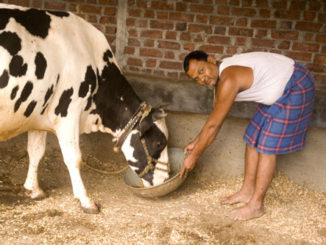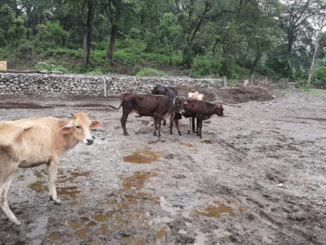Evaluation of herd fertility in bovines depends upon:
- Quantification of certain data
- Accuracy of evaluation depends on quantity and quality of information provided
- Minimum information required for evaluation is:
- Animal identity
- Last calving date
- First and subsequent service or insemination dates
- Confirmation of pregnancy
Measurement of fertility
It can be made on the basis of following parameters :
- Non return rate to first insemination
- Calving interval & Calving index
- Calving to conception intervals
- Days open
- Calving to first service intervals
- Overall pregnancy rate
- Estrus detection rate
- Distribution of interoestrus intervals
- First service submission rate .
- Reproductive efficacy
- Fertility factor
- Culling rate
- Fertility index
Non return rate to first insemination
It is the percentage of cows / heifers in a particular group over a specified period of time (usually 30 to 60 days), which has not presented for repeat insemination within the specified period. Usually this parameter is used to monitor fertility of bulls and performance of inseminators. The average figure in this parameter is high compare to calving rate to first service. The reason being
- Failure to identify, record, report when cow returns to estrus.
- Culling of cows following return to estrus
- Subsequent followed natural service
- Prenatal death
This parameter is important measure of fertility but helpful when no pregnancy diagnosis is performed.
Calving Interval (CI) and Calving Index (CID)
It is the intervals in days between two successive calving for individual cows referred as calving interval but for herd called as calving index (mean calving interval of all cows). Use traditionally as measure of fertility (how close cows are to a figure of 365 days). The major disadvantage of this parameter is that it gives overoptimistic assessment of fertility when many cows’ fails to become pregnant are culled.
Calving interval/Calving index depends upon two factors and can be represented by a formula as CI= A+ B
Where A=last calving date to date of conception and B=length of gestation.
The ideal calving interval for a cow should be 365 days, which mean A= 85 days and
B=280 days which is fixed.
Calving to Conception Interval (CCI)
It is the intervals in days from calving to effective service resulting in pregnancy. The mean CCI depends on two factors and can be represented by a formula as
Mean CCI= C + D
Where C= mean calving to first service and D= mean first service to conception. This factor C and D is equal to A of the calving interval and for an ideal calving interval this ‘A’ should be of 85 days. This means C= 65 days and D= 20 days. The CCI is an important measurement of fertility but requires a positive diagnosis of pregnancy.
Days open
It is the interval in days from calving to subsequent effective service date of those cows, which conceive while calving to culling or death for those cows that do not conceive. Normally it will be always greater than the mean calving to conception interval unless all cows that are served conceived in which case it would be the same.
Calving to first service interval
For a round the year calving herds ideally this interval should be 65 days in order to keep the CCI as 85 days. This interval is influenced by the following factors
- Breeding policy of the farm i.e. adopting a policy of early breeding to late calved animals and late breeding for early calved cows.
- Delayed returned to cyclical activity after calving i.e. true anoestrus.
- Failure to detect estrus in those cows that has resumed normal cyclical activity.
For factors like delayed return to cyclical activity, it Can be improved by regular and routine examination of animal that have failed to return to estrus by 42 days post partum and by using milk progesterone assay.
Detection of estrus can be improved when the person looking after the herd knows true signs of heat and there is a regular and routine practice of heat detection with recording all events. Also can use for estrus detection aids.
Overall pregnancy rate
It can be defined as number of services given to a defined group of cows/heifers, over a specified period of time, which resulted in confirmed pregnancy (not less than 45 days post service). Thus in a 12 months periods if 100 cows receive 180 services of which 90 resulted in confirmed pregnancy the overall pregnancy rate would be 50%. The pregnancy rate is influenced by
- Correct timing of A.I which is dependent on the accuracy of estrus detection
- Correct A.I Technique, handling and storage of semen
- Good fertility of the bull and absence of venereal diseases
- Adequate nutritional status a the time of service and afterward
- Complete uterine involution and absence of any uterine infection.
Overall pregnancy rate is an important parameter for determining reproductive efficiency and is helpful to identify the influence of management changes particularly nutrition where the parameter is evaluated on a monthly basis provided that there are a minimum of 10 services per month.
Oestrus Detection
This parameter has its role in influencing the calving to conception interval and can reduce the CCI to a greater extent if estrus detection is accurate. However, this parameter has limited influence upon overall pregnancy rate.
The usual figure in U.K. for estrus detection is 60% yet it is possible to achieve a figure of 80%. For this it is important to record all observed heat even though they occur before the earliest date for service (before 45 days). This will help the person engaged in the work of estrus detection (herdsman) to anticipate the subsequent heat and thus improve the detection rate. Also, this will enables the early detection of acyclic animals.
There are many methods for calculating estrus detection rate (ODR). Each of the mentioned method has got some measure of inaccuracy.
Ist Method: ODR= No of interservice intervals recorded/No of interservice intervals recorded + No of missed estrus period x 100
IInd Method ODR= 21/Mean interservice interval x 100
For calculating the number of missed estrus period for e.g., if the interestrus period range is 36-48 days (2 x 18-24), it indicate one missed heat. Similarly, if the range is 54-72 days (3 x 18-24) it indicates 3-missed heat.
In well-managed dairy herds where the calving to first service interval is on target, there is failure to detect return to estrus in non-pregnant cows and therefore in such cases large interestrus intervals, which are 2 to 3 times of the normal intervals, are encountered. In such condition milk progesterone estimation may be helpful.
Poor estrus detection
It could be due to
- When in small space accommodating large number of animals enabling them for exhibiting estrus signs.
- Poor lighting or identification of animals.
- Failure in recording signs of approaching estrus and signs of true estrus.
- Inadequate regimen for observing cows for signs of estrus due to the herdsmen being overworked.
Distribution of inter oestrus intervals
This parameter provides number of aspects of reproductive status o the herd. These intervals are sub divided into various groups as
- 2-17 days
- 18-24 days i.e. normal interestrus intervals
- 25-35 days twice the normal interestrus intervals.
- 36-48 days
- > 48 days
In a well-managed herd with accurate detection of estrus and presentation of service at least 45% of intervals should be within the 18-24 days range. If percentage for 36-48 days interval is high and the figure for 18-24 days interval is low than this is indicative of poor estrus detection. If large numbers of intervals are of groups (a) and (c), it suggest inaccurate identification of estrus.
If large number of intervals are in group (c) (d) and (e), it could be suggestive of late embryonic or early fetal death problem.
First service submission rate
This is a measure of how quickly cows are served after they have become eligible for service. It can be defined as the number of cows or heifers served within 21 or 24 day period after becoming eligible for service.
The earlier time after calving when a cow is ready for service is 45 days. This condition holds true for normal calved cows. However, cows suffered with dystocia or abnormal puerperium should not be served before 60 days post parrum and should be examined routinely before service. Similarly, heifers and cows giving more than 30-40 kg of milk should not be served before 50 days post-partum. A good submission rate is 80%.
The submission rate is influenced by
- The time interval to the resumption on normal ovarian cyclical activity after calving.
- Detection of estrus in those cows that have resumed normal ovarian cyclical activity.
Methods for obtaining submission rate
First Method: List all cows that are ready for service (at or beyond the earliest service date of 45 days since calving) at the start of each 21 or 24 days service period. At the end of third period identify all those that have been served.
The percentage submission rate is than calculated as
No of cows served that are listed/ No of cows that are tested x 100
Second Method : List all cows chronologically in order of calving date. Add 21 days to the earliest date on or after which they are ready for service i.e. 45+21 (24)= 66 (69) days. Thus every cow should be served before the target date of 66 or 69 days postpartum.
The submission rate is thus calculated as
No of cows served on or before the target date/ No of cows that should have been served on or before the target date
Reproductive efficiency (RE)
This index provides overall measurement of fertility and takes into account different parameters. It is represented as
RE= submission rate x overall pregnancy rate/100
Thus if a submission rate is high i.e. 80% and overall pregnancy rate is good I.e. 55% than the RE is 44. In another case where submission rate is 70%and the overall pregnancy rate is 50% the RE is 35.
The advantage of this index (RE) is if an artificially high submission rate is obtained by overzealous herdsman by presenting cows that are not in estrus will be compensated by a reduced pregnancy rate. Conversely, if an overcautious herdsman has a reduced submission rate he may have a high pregnancy rate thus producing a reasonable RE values.
Fertility factor (FF)
This measure of fertility also took into account two different parameters and can be expressed as
FF=ODR xOPR/100
Thus if ODR= 60% and OPR = 50% than FF = 50 x60/l00=30
Culling rate
This is effective in order to achieve a CI of around 365 days by culling those animals, which are slow to get in a calf. In such condition replacement after a culling is by a heifer and is a cost effective processes. Because cost of rearing a heifer is more than that of a culled animals. Ideally culling figures for infertility should not exceed 5%, thus 95% of the cow that calve and are served should become pregnant again.
Finally, Following targets are to be kept in mind for keeping the breeding efficiency of a herd comprising of cows.
| Index | Target level | Interference level |
| Mean calving to first service intervals (days) | 65 | 70 |
| Mean calving to conception (Pregnancy) interval (days) | 85 | 95 |
| Mean interval from first service to conception (pregnancy) (days) | 20 | 25 |
| Submission rate (%) | 80 | 70 |
| Overall pregnancy rate (%) | 58 | 50 |
| First service pregnancy rate (%) | 60 | 50 |
| Reproductive efficiency (%) | 46 | 35 |
| Cow served that conceive (%) | 95 | 90 |
| The content of the articles are accurate and true to the best of the author’s knowledge. It is not meant to substitute for diagnosis, prognosis, treatment, prescription, or formal and individualized advice from a veterinary medical professional. Animals exhibiting signs and symptoms of distress should be seen by a veterinarian immediately. |







Be the first to comment